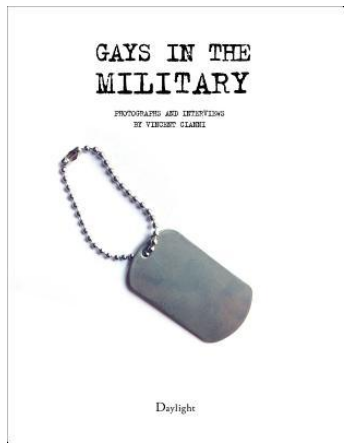 Cianni, Vincent. Gays in the Military. Daylight Books. 2014. $45 249 p. HC. 978-0-9889831-5-1.
Cianni, Vincent. Gays in the Military. Daylight Books. 2014. $45 249 p. HC. 978-0-9889831-5-1.
The United States military has only recently accepted GLBT service members into its ranks with open arms. Before September 2011, Donít Ask, Donít Tell required them to live double lives while under previous policies any GLBT military personnel could be kicked out on rumors and supposition. Prior to DADT being repealed, photographer Vincent Cianni traveled the country to photograph and interview over a hundred current and former military members about their experiences. The results of this project became this book.
This book actually feels like two books in one. The first part holds the photographs of the GLB service members taken by Cianni. The black and white portraits feature individuals from around the countries of all ages and ethnicities. One thing that comes through repeatedly in this photos is that while a few have smiling faces, most are looking away from the camera with troubled, haunted expressions. And itís not hard to understand why. Faced with difficult circumstances and a complicated past, reliving it isnít easy. Cianni mentions in his note at the end of the book that the photos were taken after the interviews, thus allowing the stories to be fresh on the minds and in the faces of his subjects.
After the photographs, Cianni includes a statement from each of the subjects about their time in the military. These statements typically tell where the person came from, their background, why they joined the military, the secrecy they lived under, and how they left the service (usually by being forced out). While not all sad, many if not most of these stories are truly heartbreaking. In an era when Donít Ask, Donít Tell and the previous military bans on homosexuality are quickly fading into history, the scars of these policies are still being felt by the hundreds and thousands of individuals living with PTSD, depression, anger, panic, and other diseases because of their treatment in the military.
While incredibly interesting, this book does require a fair amount of flipping back and forth. By the time I got through with a statement in the back of the book, I wanted to compare it to the photograph of the subject at the front of the book. I ended up keeping a bookmark in both ends so I could know where I was. I understand why the book is formatted this way: viewing the photographs isnít slowed by the statements as it would have been had they been interspersed. But it was the one thing that made reading this title less fluid.
This emotional collection captures an important moment and time in the struggle for full GLBT equality across the American landscape. It is recommended for libraries that collect GLBT nonfiction, military history, or photography.
-John Mack Freeman